In this post we’ll take a look at the initial concept for my board game.
Much like any game design, the initial concept evolves at a rapid pace. The worker placement mechanic that I had in mind for this game hasn’t really come to fruition. As I played with some rough prototypes, the worker placement element was getting in the way of the more interesting aspects of the game. Placing this on the back burner has allowed me to focus on what makes the game interesting and I have found that the game has more naturally fallen into place.
Let’s talk a bit about the game in its current form:
The Front Line
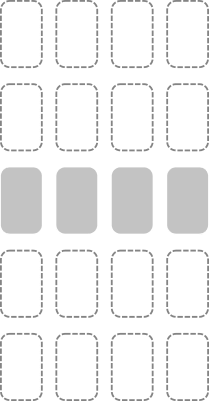
The central concept of the game is the “Front Line”; 4 cards that are placed horizontally in a line between the 2 players (represented by the filled grey cards above). Let’s also imagine a 4 x 2 grid on each side of the front line representing the possible spaces where a front line card can reside. Your goal is to move the front line such that one of the cards reaches the back row of your opponents side. This is illustrated in the animation below which demonstrates one possible way to secure a win.

Movement of the front line is restricted such that a card can only be moved if the space that it is moving to keeps a continuous line with the other 3 front line cards. This is determined by having cards either adjacent or diagonal to it. Having a gap, such as the one below, is an illegal move.
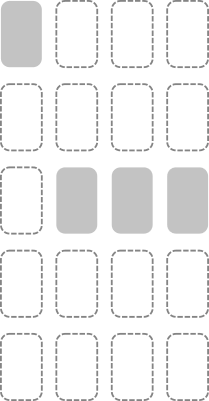
Some possible “win” conditions may look like this:
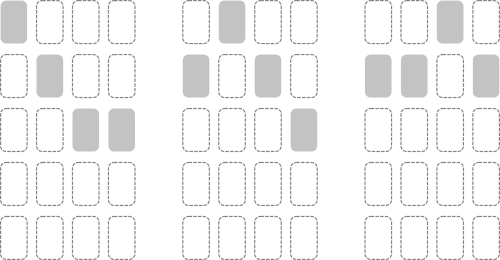
I’m still exploring possible ideas for the front line but the above describes the core concept as it exists right now.
How do you move the Front Line?
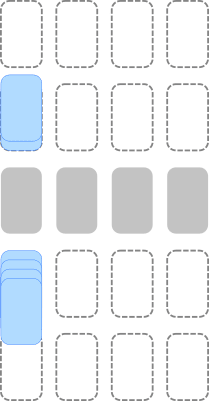
Cards are played one at a time, with each player taking a turn, directly in front of any card in the front line (depending on which side of the table you are playing on). Once a set of conditions have been met, this triggers a battle for that front line card. The resolution of this battle determines who, if anyone, gets to activate the card and move it.
To understand this, we need to look at the card types in more detail:
Front Line cards
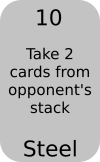
Front line cards have a number assigned to them (The large number at the top of the card above). When enough cards have been assigned to the front line card (the total number of cards, on both sides, assigned to this front line card must equal the number), then a battle is triggered.
Front line cards also have a power (The text on the card above). This power is triggered by the winner of a battle once it has been resolved.
Finally, each front line card generates a resource (Listed at the bottom of the card). Playing a card to this front line card will generate that resource. 1 resource will be generated per card that you have assigned to this front line card.
Playing a card to gain a resource (represented purely by the number of cards you have assigned to that “front” card) is how I’ve diluted the worker placement aspect of the game. By playing cards to the front line, you have a dynamic representation of how much money, steel, oil, and food (current WIP resources) that you have at any one time. Currently these are used to pay for the more powerful cards that may come into play.
Player cards

Player cards may have an attack and/or defence value assigned to them (represented by the 2A = 2 Attack, and 1D = 1 Defence in the card above). These are used during battle resolution (described below). Not all cards have attack or defence values but the card still counts towards the sum needed to trigger a battle.
Player cards may have an ability (the text in the card above). This activates as soon as the card is played.
Player cards may also have a cost associated with them (the 3 food in the card above). This means you would need at least 3 cards assigned to a front card that provides the food resource in order the play this card. The card can be played to any front card provided you have met these requirements.
Battle resolution
Battles are triggered when the total number of cards played onto a front card equals the front cards target value. At this point, the players take it in turn to do the following:
- Figure out your attack value by summing your attack values across all of your cards assigned to this front card.
- Sum your opponents defence values across all of their cards.
- Subtract your opponents defence value from your attack value to get a final attack value.
Then the following happens:
- Compare final attack values
- The player with the highest positive value wins the battle.
- The winning player activates the card ability (unless its a tie).
- All cards played on both sides are discarded (unless its a tie)
- The winning player moves the front card (if they can do so legally, otherwise it is left where it is)
- In the case of a tie: both players take their cards back after they have selected a single card each to discard and the front card is not moved (nor is the ability activated)
Only positive values can win a battle as a negative final value means that the attack was fully blocked by the opponents defence value.
Next steps
There is a lot of room for adding additional complexity/depth to the game. A few of the ideas I have:
- Headquarters – offering permanent or single-shot abilities depending on which HQ you choose
- Limitations applied to the front line cards – such as only cards of type x can be played here
- Historical battles – Front line cards could be provided as sets of 4, or more, cards that abstractly represent actual battles in history (with appropriate changes to their powers, numbers, and restrictions).
- Buildings – Either placed or static (or both). These would occupy spaces on either side of the table and offer bonus’s to your cards within that column. These could simulate defensive structures and the like. They would also help to add more depth to the historical battles just mentioned.
All of these ideas are to be explored later on once the core gameplay feels right. The next step is to brainstorm the possible abilities of both the player cards and the front line cards. I’ll be trying to answer questions like: Which abilities would be fun? Which unbalance the game? Can I create a very overpowered/under-powered card and what effect does that have.